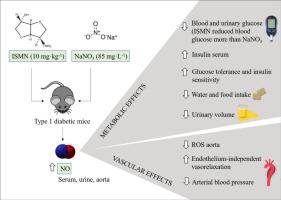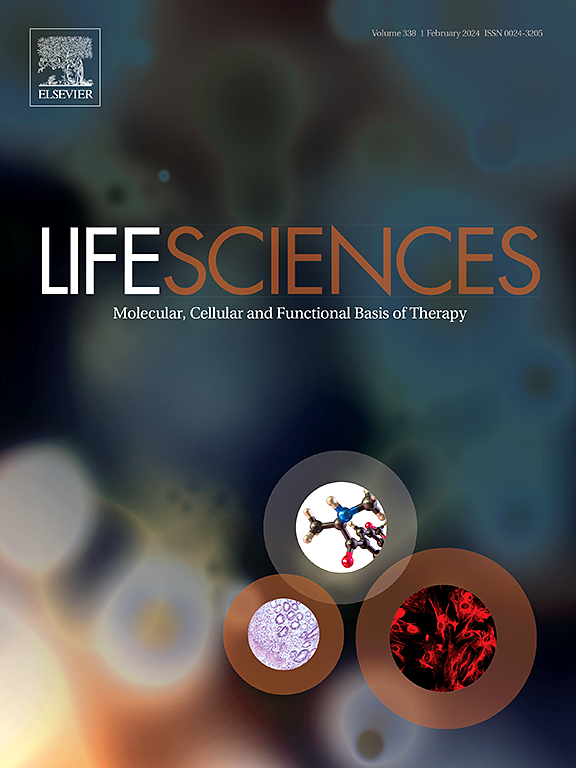Organic vs. inorganic nitrates: Metabolic and vascular outcomes in STZ-induced diabetes in mice
IF 5.2
2区 医学
Q1 MEDICINE, RESEARCH & EXPERIMENTAL
引用次数: 0
Abstract
Background
Diabetic animals often display dysregulated nitric oxide (NO) metabolism, contributing to vascular dysfunction. This study evaluates the metabolic and vascular effects of organic nitrate isosorbide mononitrate (ISMN) versus inorganic sodium nitrate (NaNO3) in mice with type 1 diabetes mellitus (T1DM) induced by streptozotocin (STZ).
Experimental approach
T1DM was induced in male C57Bl6 mice with STZ ip and confirmed by fasting glucose. Mice were treated with ISMN (10 mg·kg-1) or NaNO3 (85 mg·L-1) for 14 days. A combination of in vivo, in vitro, and ex vivo studies assessed cardiometabolic benefits.
Results
Both nitrates reduced blood and urinary hyperglycemia in T1DM mice, with ISMN exhibiting more significant reductions in blood glucose. ISMN and NaNO3 similarly reduced water and food intake, urinary volume, glucose intolerance, and insulin resistance while increasing insulin and nitrite levels in serum and urine. Both nitrates improved endothelium-independent vascular function and attenuated reactive oxygen species (ROS) while increasing NO levels in the aortic rings of T1DM mice. Furthermore, both nitrates similarly reduced mean arterial pressure in T1DM mice.
Conclusion and implications
ISMN and NaNO₃ have demonstrated comparable hypotensive and antioxidant effects, offering metabolic and vascular benefits in STZ-TDM1 mice. The more pronounced reduction in blood glucose with ISMN treatment compared to NaNO₃ is particularly promising. The antihyperglycemic effects of both nitrates were linked to increased serum insulin levels and enhanced insulin sensitivity. These results provide a foundation for future clinical studies to evaluate the potential of ISMN or NaNO3 as antidiabetogenic and antihypertensive adjuvant therapies in diabetic patients.

有机硝酸盐与无机硝酸盐:STZ诱导的糖尿病小鼠的代谢和血管结果。
背景:糖尿病动物经常出现一氧化氮(NO)代谢失调,导致血管功能障碍。本研究评估了有机硝酸盐单硝酸异山梨酯(ISMN)与无机硝酸钠(NaNO3)对链脲佐菌素(STZ)诱导的 1 型糖尿病(T1DM)小鼠代谢和血管的影响:用 STZ ip 诱导雄性 C57Bl6 小鼠患上 T1DM,并通过空腹血糖进行确认。用 ISMN(10 mg-kg-1)或 NaNO3(85 mg-L-1)治疗小鼠 14 天。结合体内、体外和体外研究评估了硝酸盐对心脏代谢的益处:结果:两种硝酸盐都能降低 T1DM 小鼠的血液和尿液中的高血糖,其中 ISMN 对血糖的降低更为显著。ISMN 和 NaNO3 同样减少了水和食物摄入量、尿量、葡萄糖不耐受和胰岛素抵抗,同时提高了血清和尿液中的胰岛素和亚硝酸盐水平。这两种硝酸盐都能改善 T1DM 小鼠主动脉环的内皮依赖性血管功能,减少活性氧(ROS),同时提高 NO 水平。此外,这两种硝酸盐同样降低了 T1DM 小鼠的平均动脉压:ISMN和NaNO₃具有类似的降压和抗氧化作用,对STZ-TDM1小鼠的代谢和血管有益。与 NaNO₃相比,ISMN 治疗能更明显地降低血糖,这一点尤其值得期待。两种硝酸盐的降血糖作用都与血清胰岛素水平升高和胰岛素敏感性增强有关。这些结果为今后的临床研究奠定了基础,以评估 ISMN 或 NaNO3 作为糖尿病患者抗糖尿病和抗高血压辅助疗法的潜力。
本文章由计算机程序翻译,如有差异,请以英文原文为准。
求助全文
约1分钟内获得全文
求助全文
来源期刊

Life sciences
医学-药学
CiteScore
12.20
自引率
1.60%
发文量
841
审稿时长
6 months
期刊介绍:
Life Sciences is an international journal publishing articles that emphasize the molecular, cellular, and functional basis of therapy. The journal emphasizes the understanding of mechanism that is relevant to all aspects of human disease and translation to patients. All articles are rigorously reviewed.
The Journal favors publication of full-length papers where modern scientific technologies are used to explain molecular, cellular and physiological mechanisms. Articles that merely report observations are rarely accepted. Recommendations from the Declaration of Helsinki or NIH guidelines for care and use of laboratory animals must be adhered to. Articles should be written at a level accessible to readers who are non-specialists in the topic of the article themselves, but who are interested in the research. The Journal welcomes reviews on topics of wide interest to investigators in the life sciences. We particularly encourage submission of brief, focused reviews containing high-quality artwork and require the use of mechanistic summary diagrams.
 求助内容:
求助内容: 应助结果提醒方式:
应助结果提醒方式:


